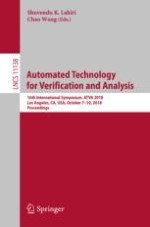2018 | OriginalPaper | Chapter
Quadratic Word Equations with Length Constraints, Counter Systems, and Presburger Arithmetic with Divisibility
Authors : Anthony W. Lin, Rupak Majumdar
Published in: Automated Technology for Verification and Analysis
Publisher: Springer International Publishing
Activate our intelligent search to find suitable subject content or patents.
Select sections of text to find matching patents with Artificial Intelligence. powered by
Select sections of text to find additional relevant content using AI-assisted search. powered by
